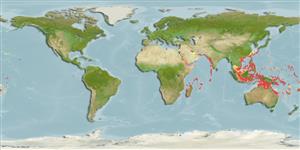Common names from other countries
Teleostei (teleosts) >
Gobiiformes (Gobies) >
Gobiidae (Gobies) > Gobiinae
Etymology: Paragobiodon: Greek, para = the side of + Latin, gobius = gudgeon + Greek,odous =teeth (Ref. 45335).
More on author: Bleeker.
Environment: milieu / climate zone / depth range / distribution range
Ecology
Marine; reef-associated; depth range ? - 70 m (Ref. 86942). Tropical; 30°N - 32°S, 32°E - 169°W
Indo-Pacific.
Size / Weight / Age
Maturity: Lm ? range ? - ? cm
Max length : 4.0 cm TL male/unsexed; (Ref. 2798)
Dorsal spines (total): 7; Dorsal soft rays (total): 8 - 10; Anal spines: 1; Anal soft rays: 8 - 9. Green to greenish yellow in color, often with a dark caudal margin; adults with elongate flaps on top of head (Ref. 1602). Transverse scales 10. Mouth nearly vertical, lips thick. Head and nape naked to first dorsal fin origin. Gill opening located at same level as pectoral base. Ventral small; first dorsal and anal lower than 2nd dorsal; pectoral extends beyond anus; caudal rounded. Scales less firmly attached than other congeneric species (Ref. 43541).; characterized further by having longitudinal scale series 22-24; ctenoid scales except head, nape, prepectoral region, breast and midventral portion of abdomen which is scaleless; head and nape with numerous bristle-like cirri; complete pelvic fin frenum and basal membrane; depth of body at level of pelvic fins 2.6-3.1 in SL (Ref. 90102).
Found exclusively among branches of Seriatopora hystrix coral (Ref. 2334); usually in pairs. Monogamous (Ref. 52884).
Life cycle and mating behavior
Maturities | Reproduction | Spawnings | Egg(s) | Fecundities | Larvae
Monogamous mating is observed as both obligate and social (Ref. 52884).
Randall, J.E., G.R. Allen and R.C. Steene, 1990. Fishes of the Great Barrier Reef and Coral Sea. University of Hawaii Press, Honolulu, Hawaii. 506 p. (Ref. 2334)
IUCN Red List Status (Ref. 130435)
CITES (Ref. 128078)
Not Evaluated
Threat to humans
Harmless
Human uses
Fisheries: commercial; aquarium: commercial
Tools
Special reports
Download XML
Internet sources
Estimates based on models
Preferred temperature (Ref.
115969): 25 - 29.3, mean 28.2 (based on 1954 cells).
Phylogenetic diversity index (Ref.
82804): PD
50 = 0.5156 [Uniqueness, from 0.5 = low to 2.0 = high].
Bayesian length-weight: a=0.01995 (0.00906 - 0.04395), b=3.01 (2.83 - 3.19), in cm Total Length, based on all LWR estimates for this body shape (Ref.
93245).
Trophic level (Ref.
69278): 3.1 ±0.3 se; based on size and trophs of closest relatives
Resilience (Ref.
120179): High, minimum population doubling time less than 15 months (Preliminary K or Fecundity.).
Fishing Vulnerability (Ref.
59153): Low vulnerability (10 of 100).
